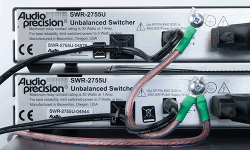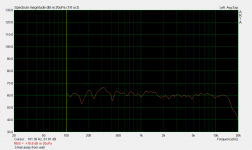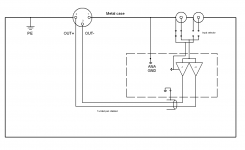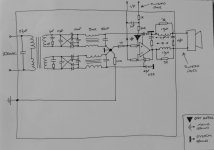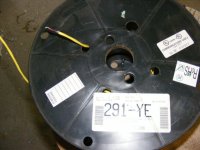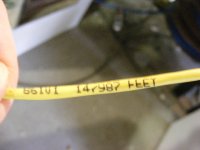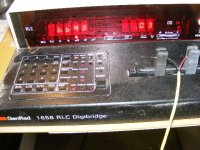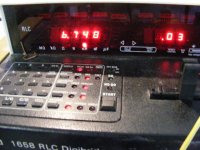Question:
How many here connect mains ground to their system ground ?
Not talking about connect mains ground to the metal case - that's a must for safety.
So I could rephrase the question . . . How many people connect their system ground the metal chassis of the cases in the comprising their system.
If you do connect it, do you connect it in one place only or several places ?
For me at present my DAC system ground is connected to to mains ground but my amps system grounds are connected to mains via 100R resistors.
Wondering about the impact on sound quality of different options
This is how Audio Precision sometimes does it:
Attachments
14db scale, pretty bumpy ride, how much smoothing ? the high frq roll off is typical when off mic axis ...
It's 1/6th octave smoothing. Yeah, I was surprised cause I took measurements before using different mic software and it measured much smoother as I recall. But, this should be accurate I think. It's a well regarded commercial loudspeaker so must be room acoustics ...
Here's the response of my new speaker, home built dipole and my active crossover ... it's more representative of the response I think will work well for me. Still working on it.
Attachments
Except, I cheated! Separated the audio, upsampled to 192/24, this suits the PC/DAC better - ensures that the vocals are totally clean.
However, yesterday I was getting clean sound, today it's a bit sludgy - what's going on?? What's different ... okaaayy ... got Windows Explorer open, and an audio CD in the drive - take CD out, close Explorer ... aahh, that's better!! Even though many people pooh pooh processor activity affecting things, this can easily be the difference between the sound being acceptable, or not - with 'difficult' recordings it's very much "everything matters" territory ...
It has nothing to do with your equipment. Your ear brain system has come to the realization that - admit it - it has no artistic merit, its been compressed to hell and back so it can particiapte with credibility in the loudness wars, and its just plain bad stuff 😀
I do BTW have about 5 or 6 of their CD's . . . so I am a fan - just not of that CD.
The other one I could never get my head around was Yes' 'Relayer' . . . after 'Fragile' 'Close to the Edge' etc they seemed to have lost it - although I am not quite sure about the chronology.
Last edited:
So I could rephrase the question . . . How many people connect their system ground the metal chassis of the cases in the comprising their system.
Connected, in one place only - within the integrated amp. Not directly connected but rather via a multi-segmented wound CM choke. This to give a low impedance at DC but hopefully just the parasitic capacitance of the choke at HF.
That's too bad, I would have thought there is not much better for 1 Ohm speakers (50uOhms/ft).
The 50uohm/ft would only apply at very low freqs. With such thick cables, skin and proximity effects bring about a significant rise throughout the audio band.
.... As a side note while setting up the audience mike by chance I tipped on one of the mike cord that was coiled up ....
Setting the microphone(s) for Telarc? Are you one of those union people?
Question:
How many here connect mains ground to their system ground ?
Not talking about connect mains ground to the metal case - that's a must for safety.
So I could rephrase the question . . . How many people connect their system ground the metal chassis of the cases in the comprising their system.
If you do connect it, do you connect it in one place only or several places ?
For me at present my DAC system ground is connected to to mains ground but my amps system grounds are connected to mains via 100R resistors.
Wondering about the impact on sound quality of different options
Review the image attached. For best results, you have to measure interference residuals. Power amplifier is balanced with pin 1 tied to the metal case as well.
Attachments
You're pretty keen on stomping that poor, poor album to death, 😀 !! Doesn't bother me either way, "artistic merit" doesn't come into it - I've never been into REM, for any particular reason, for or against - but I see albums like this as being very useful, for the purpose of assessing a system's replaying capability. My PC's abilities are only reasonable, but it works well enough so that I can 'see' to what SQ level a recording would be able to go. And that REM album would be able to fully open up, because the intrinsic content is not distorted in the measurement sense, its problem is that it's highly congested - the reason I can say that is because I've investigated tracks from other groups which are much worse, and have managed to rein them in ...It has nothing to do with your equipment. Your ear brain system has come to the realization that - admit it - it has no artistic merit, its been compressed to hell and back so it can particiapte with credibility in the loudness wars, and its just plain bad stuff 😀
The real point is that evolving a system to comfortably handle music constructed like that means it has become 'a system for all seasons' - nothing you can throw at it will faze it, it will always get the best out of any recording ...
Thanks for posts about grounding.
Recently, I added JFet buffer stages in front of my amps so I could have line filters and low impedance drive for the amp inputs. It surprised me how much this buffer improved the sound - more clarity & detail. This, and Pavel's remark about how going balanced resolves some residual noise issues got me thinking yet again about the noise reduction measures in my SE system.
My amps PSU / noise reduction schemes are shown. The only measure not yet taken is the choke in the speaker earth lead - everything else is in place. I know John does not like o/p chokes in amps but despite repeated attempts to hear anything bad from them I really can't hear any negative effects.
I am planning to do a similar scheme in my DAC so the entire system ground is only connected to mains ground via three 100R resisitors. I'm hoping this will bring further improvements - will report later.
I know that balanced working eradicates many noise issues in a very elegant way so those of you having made the jump to balanced probably find my extensive noise reduction measures in my SE amps amusing, but I'm sure with all these measures in place the difference between balanced working & SE amps residual noise is reduced somewhat.
I will be going over to balanced soon but gonna see what I can how good I can get SE first.
mike
Recently, I added JFet buffer stages in front of my amps so I could have line filters and low impedance drive for the amp inputs. It surprised me how much this buffer improved the sound - more clarity & detail. This, and Pavel's remark about how going balanced resolves some residual noise issues got me thinking yet again about the noise reduction measures in my SE system.
My amps PSU / noise reduction schemes are shown. The only measure not yet taken is the choke in the speaker earth lead - everything else is in place. I know John does not like o/p chokes in amps but despite repeated attempts to hear anything bad from them I really can't hear any negative effects.
I am planning to do a similar scheme in my DAC so the entire system ground is only connected to mains ground via three 100R resisitors. I'm hoping this will bring further improvements - will report later.
I know that balanced working eradicates many noise issues in a very elegant way so those of you having made the jump to balanced probably find my extensive noise reduction measures in my SE amps amusing, but I'm sure with all these measures in place the difference between balanced working & SE amps residual noise is reduced somewhat.
I will be going over to balanced soon but gonna see what I can how good I can get SE first.
mike
Attachments
One track that has always sounded 'wrong' to me is "Pete Townshend - You Better You Bet".The real point is that evolving a system to comfortably handle music constructed like that means it has become 'a system for all seasons' - nothing you can throw at it will faze it, it will always get the best out of any recording ...
On lesser gear it sounds like there is an odd tape head alignment problem,...or something.
However, on good gear it changes, and becomes a really, really good, interesting and fun recording actually.
Dan.
Reducing 1/f noise is everything.Thanks for posts about grounding.
Recently, I added JFet buffer stages in front of my amps so I could have line filters and low impedance drive for the amp inputs. It surprised me how much this buffer improved the sound - more clarity & detail. This, and Pavel's remark about how going balanced resolves some residual noise issues got me thinking yet again about the noise reduction measures in my SE system.
Dan.
My amps PSU / noise reduction schemes are shown.
You show a 1nF RF reduction cap on the input. You may well find an improvement moving its 0V connection to a dedicated wire to the star earth. As its shown it'll couple common-mode noise to the signal wire as the ground at the cable entry point is a dirty one, polluted by CM noise from the source equipment.
Reducing 1/f noise is everything.
Dan.
If I understand you correctly I disagree with you on that Dan.
1/f noise in 1 type of noise.
Other types are:
Diode switching noise, secondary resonance noise, other spurious resonance noise, FB loop instability resonance noise, mains noise, earth line noise, bad connection noise, RF pick up noise, noise from digital switching etc etc . . .
Perhaps some may not refer to all of these as noise but if it isn't 2nd, 3rd, 4th or 5th HD then I tend to lump it all together into one undesirable category - to be eradicated as much as is possible.
Any one of these noise sources can spoil the sound but I have the feeling that random noise is more benign than noise with some kind of pattern that is completely unconnected to the signal.
You show a 1nF RF reduction cap on the input. You may well find an improvement moving its 0V connection to a dedicated wire to the star earth. As its shown it'll couple common-mode noise to the signal wire as the ground at the cable entry point is a dirty one, polluted by CM noise from the source equipment.
Thx for this - I'll check it out
. . . and I just noticed I missed out the 10K i/p resistor that should be treated the same way perhaps
Last edited:
Sure, all these noise (distortion) sources add junk, but ime/imo really LF noise spoils the party.....think about it, VLF noise adds a layer of IMD.If I understand you correctly I disagree with you on that Dan.
1/f noise in 1 type of noise.
Other types are:
Diode switching noise, secondary resonance noise, other spurious resonance noise, FB loop instability resonance noise, mains noise, earth line noise, bad connection noise, RF pick up noise, noise from digital switching etc etc . . .
Perhaps some may not refer to all of these as noise but if it isn't 2nd, 3rd, 4th or 5th HD then I tend to lump it all together into one undesirable category - to be eradicated as much as is possible.
Any one of these noise sources can spoil the sound but I have the feeling that random noise is more benign than noise with some kind of pattern that is completely unconnected to the signal.
Reducing that VLF noise, or changing the spectrum of that VLF noise changes everything.
Dan.
Almost everybody loves vinyl. Vinyl groove = 1/f noise at so much quantities that no electronics would produce something similar.
The 50uohm/ft would only apply at very low freqs. With such thick cables, skin and proximity effects bring about a significant rise throughout the audio band.
The surface area is still a lot more than #10 zipcord. 1" schedule M pipe is almost exactly two skin depths at 20kHz, maybe an optimum choice. Can't find the exact resistance but a pair maybe 150 uOhms/ft (guesstimate).
EDIT - wow! I actually found someone who makes 12" copper buss tubing.
(Plenty of sources for 18'' copper bus tube. A bit difficult to cross while serving tea, maybe )
I LOVE VINYL. 1/f noise is important, but MANY good sources make 1/f noise: Condenser microphones, analog tape recorders, AND vinyl playback.
However, it is silly to forgo analog, just to minimize 1/f noise, and get digititis instead.
However, it is silly to forgo analog, just to minimize 1/f noise, and get digititis instead.
A photo essay for Scott. 45' WPW 291 on a spool and uncoiled.
Plastic spool of wire.
Footage marking end connected to bridge.
Reading uncoiled
Footage marking at far end.
Reading recoiled.
Plastic spool of wire.
Footage marking end connected to bridge.
Reading uncoiled
Footage marking at far end.
Reading recoiled.
Attachments
Last edited:
- Status
- Not open for further replies.
- Home
- Member Areas
- The Lounge
- John Curl's Blowtorch preamplifier part II
